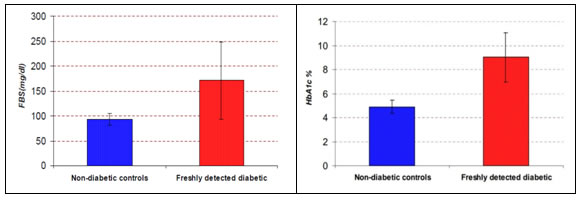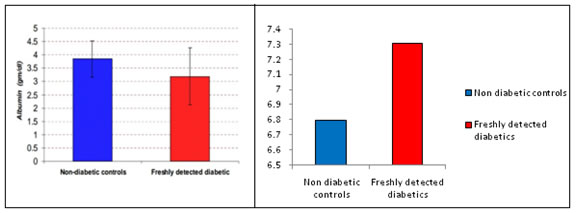Official Journals By StatPerson Publication
|
Table of Content - Volume 3 Issue 3 - September 2017
Total proteins, albumin and HBA1c in type 2 diabetes mellitus
F A Nazki1, A Syyeda2*, S Mohammed3
1,3Resident PG, 2Professor, Department of Biochemistry, Deccan College of Medical Sciences, Hyderabad-500058, Andhra Pradesh, INDIA. Email: syyedaanees69@gmail.com
Abstract Type 2 diabetes mellitus is a metabolic disorder characterized by insulin resistance [affecting carbohydrate, lipid and protein metabolism]. Glycation of proteins, including hemoglobin and albumin have been implicated in complications of diabetes. The aim of the present study was to evaluate the association between variations in the levels of albumin and total proteins with glycated hemoglobin [HbA1c]. Present study involved 408 participants who visited Owaisi Hospital and Research Center, Hyderabad from November 2015 to June 2017. 204 were freshly detected diabetic patients and 204, age and sex matched healthy controls. Fasting blood glucose levels, HbA1c, plasma total proteins and plasma albumin were estimated. The objective was to analyze the association between total proteins, albumin and HbA1c in newly diagnosed cases of Type 2 Diabetes Mellitus. HbA1c levels increased (p<0.001) from 4.90 ± 0.53 in controls to 9.02 ± 2.06 in cases, plasma albumin levels were decreased (P<0.50) from 3.85 ± 0.68 in controls to 3.19 ± 1.07 in cases and plasma total protein levels were increased from 6.8±0.81 in controls to 7.31±0.93 [p< 0.0013*] in cases. Globulin levels increased (P<0.50) from 1. 68 ± 0.29 in controls to 1.74 ± 0.57 in cases. A/G ratio levels decreased (P<1.20) from 2.31 ± 0.43 in controls to 1.84± 0.36 in cases. Glycation accelerates albumin degradation via increasing catabolic rate and decreasing protein half-life, and competes with other proteins for glycation. Our study showed a negative correlation between HbA1c and serum albumin. Freshly detected diabetic patients were associated with increased total proteins and decreased A/G ratio. We observed in our study that albumin levels may be associated inversely with HbA1c values. Our results may lead us to study the ways in which glucose and proteins may interact in a newer approach and could aid in understanding hyperglycemia and its estimation. Key Words: Albumin, HbA1c, total proteins, Type 2 Diabetes mellitus.
INTRODUCTION Insulin resistance in Type 2 diabetes mellitus affects the metabolism of carbohydrates, lipids and proteins1 HbA1c gives an estimate of the average blood glucose levels of the previous three months in diabetes. Protein glycation and HbA1c have been shown to be involved in long term complications of diabetes mellitus. Glycated albumin has decreased half life due to increased catabolic rate2,3. Studies have shown decreased albumin levels associated with increased HbA1c and total proteins.1,3,12. American diabetic association recommends HbA1c as a diagnostic tool for diabetes. However, levels of total proteins and albumin are not routinely estimated in diabetes. The present study was planned to correlate the levels of HbA1c with albumin and total proteins
MATERIALS AND METHODS The present study was conducted on 408 participants who visited Owaisi Hospital and Research Center [OHRC], Hyderabad from November 2015 to June 2017. 204 were freshly detected diabetic patients and 204, age and sex matched healthy controls. Fasting blood glucose levels, HbA1c, plasma total proteins and plasma albumin were estimated. Inclusion Criteria: 204 freshly diagnosed cases {<5 years duration} of diabetes mellitus who came to the out patients department of OHRC.204 non diabetic subjects matched with age and sex were taken as controls. Exclusion Criteria: All patients who were Obese, under nourished, anemic, hypertensive, had chronic inflammatory liver disease, epilepsy, renal disorders, known chronic diabetics, smokers and psychiatric patients were excluded from the study. This study was approved by the Medical Ethics Committee of the institute. Blood samples were drawn from the antecubital vein under aseptic precautions, after a written consent and used for the estimation of fasting blood glucose levels by Hexokinase4,5 method, HbA1c by immunoturbidimetry6,7, total proteins by Biuret8 method, albumin by Bromo cresol green method10 All estimations were done on Roche Cobas C 311 auto analyzer. The analytes estimated are subjected to standard quality control (QC) guidelines. The clinical biochemistry lab of OHRC is a participant of External Quality Assurance Scheme (EQAS) from CMC Vellore. Internal quality assessment is run twice daily (12 hourly) with both first party controls (Cobas –PCC1, PCC2) and third party controls (RANDOX). Study Design: A Comparative study with 204 subjects as non-diabetic controls and 204 subjects as freshly detected diabetics was undertaken. Descriptive statistical analysis has been carried out. Student’s t test (Unpaired, two tailed) has been used to find the significance of study parameters between non –Diabetic Controls and freshly detected diabetics. A P value of ≤0.01 was considered strongly significant, 0.01<P ≤ 0.05 moderately significant and 0.05<P<0.10 was considered suggestive of significance. Statistical Software: The Statistical software namely SPSS 22.0 was used for the analysis of the data and Microsoft word and Excel have been used to generate graphs, tables etc. Figure 1 Figure 2 Figure 3 Figure 4 Legend Figure 2: The mean HbA1c values of controls is 4.90 ± 0.53 and that patients is 9.02 ± 2.06. This increase in HbA1c values in patients compared to controls shows statistically very large effect (p< 0.001); Figure 3: The mean albumin value of control group is 3.85 ± 0.68 and that of patients is 3.19 ± 1.07. This slight decrease in albumin values in patients compared to controls shows statistically moderate effect (p< 0.05); Figure 4: Total proteins and globulin levels were high in diabetics compared to controls This elevation could be attributed to the elevation of various acute phase proteins, fibrinogen and globulins in Diabetes Mellitus. Low albumin levels and as expected, higher FBG and HbA1c were noted in diabetics.Therefore, there was a statistically
We studied the results of 408 subjects (Male = 228; Female = 180) The mean age of the patients was 50.53 ± 10 while that of controls was 48.94 ± 12.59 The mean FBS values of control is 93.41 ± 11.81 and that of patients is 171.17 ±17.07. This increase in the FBS values in patients compared to controls shows statistically very large effect (p<0.001). In our study of newly diagnosed patients of Type 2 diabetes mellitus, there was a statistically significant negative correlation between HbA1c and serum albumin levels. Total proteins were found to be significantly increased in diabetics as compared to controls. Competition between serum albumin and hemoglobin could be a factor for the negative correlation between them, besides preventing other proteins from glyctaion and altering the diabetic complications. Similar findings have been reported by other studies1,3,9,12. Increase in total proteins may be due to the elevation of acute phase proteins, globulins, fibrinogen and compounded by a decrease in the fractional synthetic rate of albumin due to insulin resistance/deficiency. Thus, low levels of albumin the body due to some other etiology may result in an over estimation of HbA1c in diabetics, as shown by Hardikar et al11. The results of our study are consistent with the above findings. This could be due to the competition between serum albumin and hemoglobin for glycation. Routine measurement of serum albumin and HbA1c may be helpful to interpret the discrepancy between the degree of glycemic control and evolution of diabetic complications. This hypothesis can be further substantiated by measuring fructosamine and a prospective study that includes pre diabetic subjects would be more beneficial.
CONCLUSION Our study showed freshly detected DM is associated with statistically significant increase in total proteins and glycated hemoglobin and decrease in albumin and A/G ratio as compared to non diabetic controls. This could lead to newer approaches to interpret interactions between glucose and proteins. Such studies could have a better impact on understanding diabetes and its complications.
REFERENCES
|
 Home
Home


